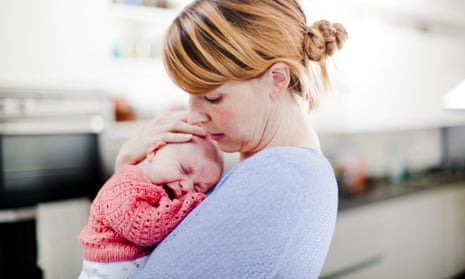Rather than stumbling back to bed in the early hours after finally soothing their crying baby, sleep-deprived parents may want to peruse the latest scientific literature on the transport of altricial mammals.
In an attempt to help those rendered numb by sleep loss, researchers have conducted a series of experiments to find out which approach to wailing infants settles them the best.
After filming parents cuddling their babies, carrying them around, rocking them in a pushchair and laying them down, the scientists arrived at an optimal strategy, or at least one that fared better than others.
Writing in Current Biology, the team recommend that parents pick up their crying baby, walk around with them for five minutes – without any abrupt stops or sudden changes in direction – and then sit down and hold them for five to eight minutes before laying them back down again.
“Excessive crying, especially during the night-time, is shown to be a major source of parental stress,” said Dr Kumi Kuroda, of the Riken Center for Brain Science in Saitama, Japan. “This roughly 15-minute method is worth trying before they start seriously worrying about what’s wrong with the baby.”
The insight emerged from research on altricial mammals – those that are helpless at birth – such as cats, dogs, mice, squirrels and, notably, humans. Studies show that when carried by their mothers, the young become more docile, an effect called the “transport response”. Because animals often move their young to evade imminent danger, the response may have evolved through improved offspring survival rates.
The researchers used video recordings and baby heart monitors to rank four different approaches to soothing crying babies: holding the child while seated, putting them in a cot, holding them while walking, or rocking them in a pushchair or similar. Crying decreased only when babies were in motion, either being rocked or carried around. Sitting still with the baby or putting it in a cot did nothing to stem the tears.
After being carried around for five minutes, all of the wailing babies had stopped crying and nearly half of them had fallen asleep, the researchers report. But even for those parents whose babies settled, the danger was far from over. About a third of the babies woke again almost as soon as they were put back to bed.
To find out what roused the infants, the scientists delved into the heart monitor data. This showed that the babies’ heart rates sometimes rose enough to wake them when physical contact with the parent was broken. Trying to lie the baby down more gently made no difference. What did help was sitting with the sleeping baby for five to eight minutes after walking around so they fell into a deeper stage of sleep.
While the approach worked better than the rest, the scientists are not claiming it is a magic bullet for sleep-deprived parents. The research on 21 infants in Japan and Italy is “exploratory”, with results that need checking in larger studies.
“Babies can have sleepless nights for very different reasons,” said Gianluca Esposito, a professor of developmental psychology and co-author on the paper at the University of Trento. “If the baby has a stomach ache, I don’t think this will do much. Unfortunately, I think many parents will still have sleepless nights. That’s part of being a parent.”
Prof Ian St James-Roberts, who has studied soothing techniques for crying babies at the UCL Institute of Education, said he hoped the team would continue their work. “Other studies of the use of parental carrying exist and generally indicate that babies cry less when carried,” he said. “It would be good to know whether these new, more detailed guidelines improve things further.”
“Crying is an important and normal communication method for babies – crying gives your baby a voice,” said Dr Betty Hutchon at the Brazelton Centre UK. “Babies have different cries for different needs such as tiredness, discomfort, hunger or wanting to be held and played with. Over time parents learn through trial and error and experience what each cry means. There is no one answer or strategy that suits all crying babies’ needs at all times – different responses will be appropriate at different times.”
